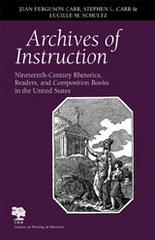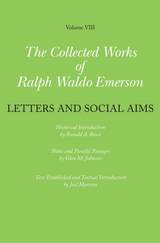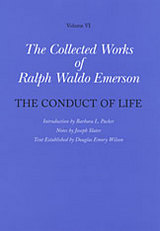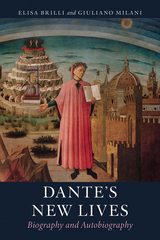
Both a historical recovery and a critical rethinking of the functions and practices of textbooks, Archives of Instruction: Nineteenth-Century Rhetorics, Readers, and Composition Books in the United States argues for an alternative understanding of our rhetorical traditions. The authors describe how the pervasive influence of nineteenth-century literacy textbooks demonstrate the early emergence of substantive instruction in reading and writing. Tracing the histories of widespread educational practices, the authors treat the textbooks as an important means of cultural formation that restores a sense of their distinguished and unique contributions.
At the beginning of the nineteenth century, few people in the United States had access to significant school education or to the materials of instruction. By century’s end, education was a mass—though not universal—experience, and literacy textbooks were ubiquitous artifacts, used both in home and in school by a growing number of learners from diverse backgrounds. Many of the books have been forgotten, their contributions slighted or dismissed, or they are remembered through a haze of nostalgia as tokens of an idyllic form of schooling. Archives of Instruction suggests strategies for re-reading the texts and details the watersheds in the genre, providing a new perspective on the material conditions of schooling, book publication, and emerging practices of literacy instruction. The volume includes a substantial bibliography of primary and secondary works related to literacy instruction at all levels of education in the United States during the nineteenth century.

Letters and Social Aims, published in 1875, contains essays originally published early in the 1840s as well as those that were the product of a collaborative effort among Ralph Waldo Emerson, his daughter Ellen Tucker Emerson, his son Edward Waldo Emerson, and his literary executor James Eliot Cabot. The volume takes up the topics of “Poetry and Imagination,” “Social Aims,” “Eloquence,” “Resources,” “The Comic,” “Quotation and Originality,” “Progress of Culture,” “Persian Poetry,” “Inspiration,” “Greatness,” and, appropriately for Emerson’s last published book, “Immortality.”The historical introduction demonstrates for the first time the decline in Emerson’s creative powers after 1865; the strain caused by the preparation of a poetry anthology and delivery of lectures at Harvard during this time; the devastating effect of a house fire in 1872; and how the Emerson children and Cabot worked together to enable Emerson to complete the book. The textual introduction traces this collaborative process in detail and also provides new information about the genesis of the volume as a response to a proposed unauthorized British edition of Emerson’s works.Historical Introduction by Ronald A. Bosco
Notes and Parallel Passages by Glen M. Johnson
Text Established and Textual Introduction and Apparatus by Joel Myerson

The essays in this book, first published in 1860, were developed from a series of lectures on "The Conduct of Life" delivered by Emerson during the early 1850s. Some of the original lectures were dropped and the rest were considerably revised, with new topics introduced. The published essays, on "Fate," "Power," "Wealth," "Culture," "Behavior," "Worship," "Considerations by the Way," "Beauty," and "Illusions," show Emerson's interest in many practical aspects of human life, and reflect his increasing involvement in politics--chiefly in the antislavery movement--during the decade before the Civil War.
This edition is based on Emerson's holograph manuscripts and published sources. The text incorporates Emerson's later corrections and revisions, and shows us what he actually wrote (or, perhaps in some cases, intended to write).
The historical introduction traces the book's development and its relation to Emerson's own personal growth and political awareness. Joseph Slater's explanatory notes help the modern reader to understand many of Emerson's references and allusions that may not be readily apparent.
Historical Introduction by Barbara L. Packer
Notes by Joseph Slater
Text Established and Textual Introduction and Apparatus by Douglas Emory Wilson

Ralph Waldo Emerson’s second collection of essays appeared in 1844, when he was forty-one. It includes eight essays—“The Poet,” “Experience,” “Character,” “Manners,” “Gifts,” “Nature,” “Politics,” and “Nominalist and Realist”—and one address, the much misunderstood “New England Reformers.” Essays: Second Series has a lightness of tone and an irony absent from the earlier writings, but it is no less memorable: “a sermon to me,” Carlyle wrote, “a real word.”
The present edition, drawing on the vast body of Emerson scholarship of the last forty years, incorporates all the textual changes Emerson made or demonstrably intended to make after 1844. It records variant wordings and recounts the development of the text before and after publication. A list of parallel passages makes it possible to trace Emerson’s extensive use of material from his journals, notebooks, and lectures. Endnotes provide information about people, events, and now-obscure terms. A brief historical introduction places the book in the context of the years during which it was written, the time of Brook Farm, The Dial, and the death of Emerson’s five year-old son.
Historical Introduction and Notes by Joseph Slater
Text Established by Alfred R. Ferguson and Jean Ferguson Carr
Textual Introduction and Apparatus by Jean Ferguson Carr

Some of Ralph Waldo Emerson’s finest and most famous essays, such as “Self-Reliance,” “Compensation,” and “The Over-Soul,” appeared in his Essays of 1841, published when he was thirty-seven years old. Preceded by the slim volume Nature, it was his first full-length book.
The present edition provides for the first time an authoritative text of the Essays, together with an introduction, notes, and supplementary material of great value for the study of Emerson’s creative processes. A list of hundreds of parallel passages in his earlier journals and lectures makes it possible to examine in detail how he drew upon those manuscripts (now published), especially the voluminous journals, as grist for the twelve essays. His subsequent alterations of the essays, particularly in the revised edition of 1847, give evidence of the evolution of his thought and style at this stage of his career. While the text incorporates his revisions, so as to represent his final intention, the earlier versions are given at the end of the book.
Introduction and Notes by Joseph Slater
Text Established by Alfred R. Ferguson and Jean Ferguson Carr

Ralph Waldo Emerson, Alfred Kazin observes in his Introduction, “was a great writer who turned the essay into a form all his own.” His celebrated essays—the twelve published in Essays: First Series (1841) and eight in Essays: Second Series (1844)—are here presented for the first time in an authoritative one-volume edition, which incorporates all the changes and corrections Emerson made after their initial publication.
The text is reproduced from the second and third volumes of The Collected Works of Ralph Waldo Emerson, a critical edition which draws on the vast body of Emerson scholarship of the last half century. Alfred R. Ferguson was founding editor of the edition, followed by Joseph Slater (until 1996).
READERS
Browse our collection.
PUBLISHERS
See BiblioVault's publisher services.
STUDENT SERVICES
Files for college accessibility offices.
UChicago Accessibility Resources
home | accessibility | search | about | contact us
BiblioVault ® 2001 - 2024
The University of Chicago Press









